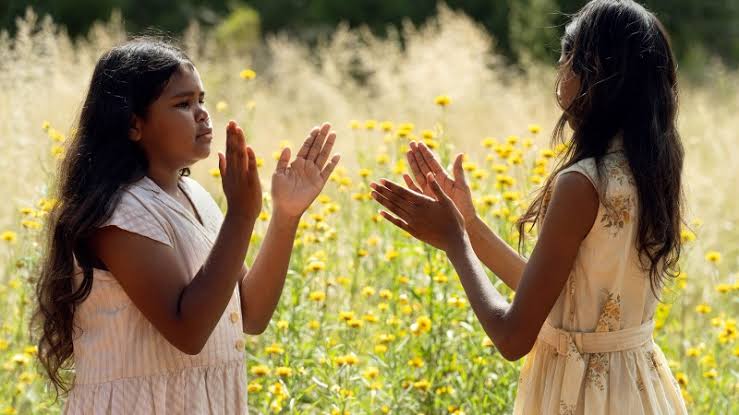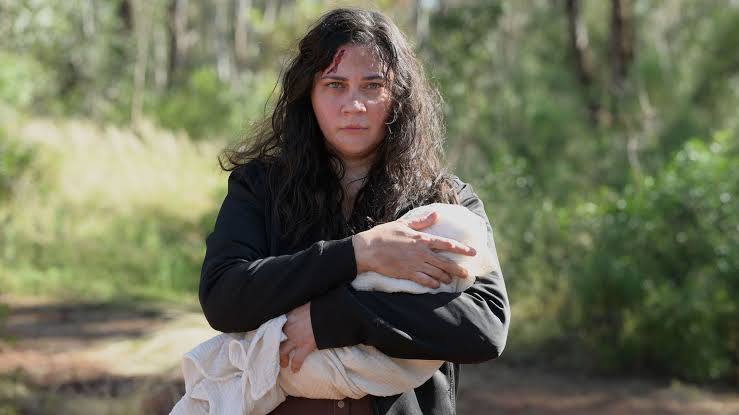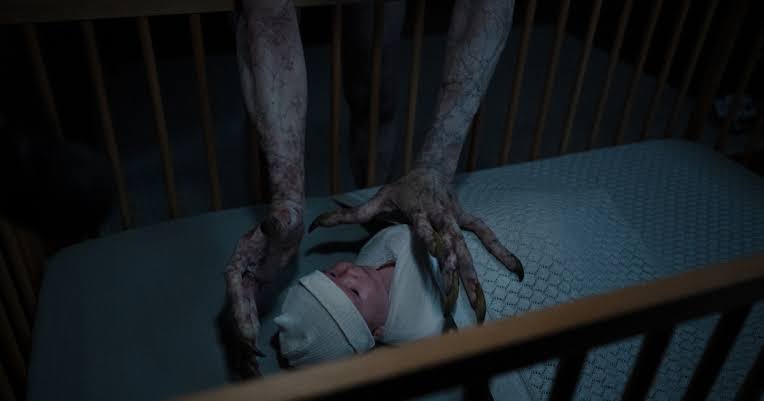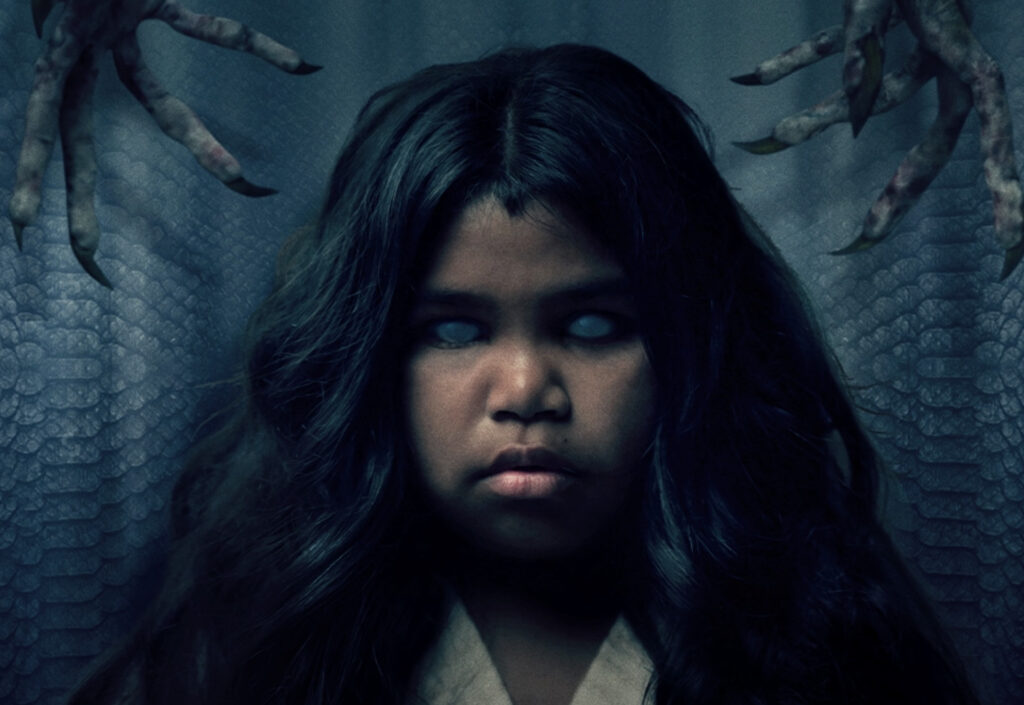Director: Jon Bell
Writer: Jon Bell
Stars: Shari Sebbens, Meyne Wyatt, Tessa Rose
Synopsis: A young Aboriginal couple brings home their second baby. What should be a joyous time takes a sinister turn, as the baby’s mother starts seeing a malevolent spirit she is convinced is trying to take her baby.
Jon Bell’s full-length feature expanding his award winning 2020 short of the same name is a concept stretched thin. As fascinating as the multiple ideas and issues Bell address around the trauma of the Stolen Generation of Aboriginal people in Australia and the ongoing effects of racism and the disconnect that causes with those taken in by White families; Bell never merges the folk horror aspect with the real-world issues in a well-defined manner.
Jon Bell opens the film defining what a Moogai is. In the Bundjalung Nation’s language (encompassing the region from the mid north coast of New South Wales to a small section of south Queensland in Australia) a Moogai is a ghost or spirit akin to the boogey man. A name for a White monster. The name for a monster who steals children. Bell also uses a title card to quickly explain the Stolen Generations in Australia. A governmental policy which ran ‘officially’ from 1905 through to 1967-1970 (although unofficially it went longer) where Aboriginal children were taken from their families as a form of forced assimilation where they would eventually have their Aboriginality either ‘bred’ out of them, or they would be so removed from their cultural and tribal histories that there would be only the White stories about and not for them.
In 1970, at Red River Mission, two young sisters are singing and clapping hands together when two white government officials arrive. The peaceful day is shattered as Mabel (Mary Torrens Bell) whistles for the children to hide. It’s a whistle they all know too well. And the half dozen or so kids scatter into the bush. Mabel tells the officers that there are things out there that she knows about, and they don’t. Nevertheless, they chase the children so they can take them. One of the girls, Aggie (Precious Ann) hides in a cave. Neither officer wants to go in to find her. She has escaped them, but not the Moogai.
In 2024, Sarah Bishop (Shari Sebbens) is a successful corporate lawyer rising through the ranks of her firm. Her boss congratulates her as the woman, “Apologies, “person”” who was able to negotiate with a difficult client and seal a major deal. Her friend Becky (Bella Heathcote) laughs at the pseudo-feminism of it and verbally wipes the floor with a man who claims Sarah only got the deal done because no one says no to a pregnant woman.
On the drive back to Sarah’s expensive apartment which she shares with her husband Fergus (Meyne Wyatt) and young daughter Chole (Jahdeana Mary), she and Becky are discussing Ruth (Tessa Rose), Sarah’s birth mother who has travelled south hoping to reconnect with her. It’s not going well. Sarah sees Ruth as a poorly educated interloper who was unfit to be her mother, which is why Sarah was adopted by a White couple when she was five. Annette (Tara Morice) is Sarah’s mother and Ruth someone she puts up with because Chloe and Fergus like her. As she’s explaining, they spot Ruth walking towards the apartment and give her a lift.
Fergus’ brother, Ray Boy (Clarence Thomas) is at the apartment, and it is becoming a small celebration when Sarah suddenly goes into labor. A placental abruption leads to emergency surgery where Sarah, for a moment, dies on the table after delivering baby Jacob. The dangerous delivery leaves her depleted and weak and opens her up to something more sinister – the gaze of the Moogai. At first, Sarah believes exhaustion is playing tricks on her mind. She’s certain that Chloe is misbehaving and moving Jacob around. Or that her dreams are just out of control because of the half-heard ‘superstitious nonsense’ Ruth has been spreading. Sarah goes to see the doctor who delivered Jacob and he gives her sleeping pills, not paying attention to her confused and fragile state. A young girl with white eyes whispers to her that “He’s coming,” and Sarah sees white claw-like hands over the crib in her bedroom. Fergus is concerned but he’s unable to stay home with her and she doesn’t particularly want to. She certainly doesn’t want Ruth coming over to ‘help’ – not with her dirt and bush medicine. And what would Ruth know about mothering anyway as she couldn’t manage to keep her?
It isn’t long before Sarah finds all the things people left unsaid about her being said aloud. Becky visits (mostly to ensure she gets Sarah’s help on a project) and brings champagne. Sarah hears Jacob crying (he isn’t) and tries to explain how things are falling apart. She’s losing time, maybe her mind – hallucinating. And speaking of time, she’s late to pick Chloe up from her large Catholic School (like the one she attended).
Miss Miller (Alexandra Jensen) meets Sarah at the door of the classroom. She has concerns. Miss Miller has heard about the difficult birth. She’s also concerned with some bruises on Chloe’s arm. Sarah tells her that she needs to mind her own business especially if she is suggesting she has hurt her child. Miss Miller smells the champagne on her breath and refuses to let Chloe go with Sarah. Sarah grabs for Chloe and drops Jacob in the tussle. The police are called. Becky refuses to back up that she and Sarah had only a glass or two of champagne with lunch. Suddenly, Sarah is no longer the accomplished corporate lawyer – she’s a suspected alcoholic, a suspected child abuser, and a disturbance to the peace. Perhaps the words Ruth said to her about the white man deciding Ruth was an unfit mother are starting to sink in. But Ruth isn’t there – Sarah threw her out of the house and told her she didn’t want to see her again with her stories of white-eyed children and the Moogai.
Further horrors are in store for Sarah, Chloe, baby Jacob, and Fergus. The Moogai is closing in on them and he comes at night. Fergus is at a loss at how to help Sarah. He can’t storm around the way she is in defiance. “If I yell, I’m the angry Black man,” he says and reminds her of a minor record. Annette is absent. Sarah refuses to take the sedatives she was given because they aren’t helping with what is happening to her during the day and Fergus trying to put them in her wine infuriates her. Sarah is infantilized, disbelieved, treated as hysterical, and the institutions she thought she belonged to – including her position as a lawyer – are being taken away with flimsy excuses. “Why do you all believe them and not me?” Sarah cries, but she knows the answer. She’s simply too Aboriginal to ever be accepted if even the smallest hint of a White colonial perpetrated stereotype emerges. Drunk, violent, mentally unwell. A misstep by Fergus leads to Sarah being separated from Chloe and Jacob. If she can be declared unfit and her children removed from her – how easy would it to be for Fergus to lose them too, especially without the financial support that Sarah’s job has brought in.
Jon Bell brings into play maternal horror – how quickly the medical establishment puts the label ‘postpartum psychosis’ on women. It takes only a signature for Sarah to lose her rights as a person almost completely. She was being driven into a fractured state by the White monster – the supernatural one and the social one.
Bell’s use of realism is almost perfect. Fergus finally understands that the neat grey-hued apartment overlooking a beautiful coastline is the haunted space Sarah claimed it to be when he sees the little girl – Aggie – who Chloe has also seen. She tells him to run as the Moogai’s long arms reach at the crib. Reunited, the family drive north to Ruth, they cannot sleep. The further north they go, the more dangerous it is to simply be Aboriginal in the back roads and country towns. I spent seventeen years (broken into two sections) on Bundjalung land. Nothing Bell is describing as far as real-world interactions with White authorities is over-written nor is it exaggerated. If anything, Bell pulls back on the real-world racism giving the audience enough to contextualize what is happening to Sarah and Fergus, but not pushing the piece into social realism where it is choosing to use genre as metaphor instead.
However, the final few acts of the film are clumsy. The full reveal of the Moogai (redesigned after the Sundance screenings) shows a monster that is generic – the devouring faces and grasping limbs could be from any number of creature features. There is a three generations of women showdown against the creature where the inevitable happens – Sarah embraces her Aboriginality and understands what her mother lost and how much her mother and others have suffered – how many were taken by monsters. And although Tessa Rose as Ruth gives a commanding performance, it doesn’t feel convincing. Nor does it make sense that she would wait for so long to take on the boogey man who still steals Aboriginal children. It is implied that Ruth lost her daughter, which led her down a dark path of institutionalization, but she didn’t lose her belief in indigenous stories, mythology, and healing practices. Perhaps Bell is pointing out that there too few left to tell the stories now – and White Australia still doesn’t want to listen.
The Moogai is the monster preying on Jacob and if he chooses, also Chloe. A child stealer with only Sarah standing guard. But Sarah isn’t an adequate guard while she lacks the tools to fight the predator. As much as Aggie, the spirit child, tries to give her clues how to save Jacob, and the stories she shares with Chloe, while Sarah can only see her heritage as trauma turned into resentment, she will be a product of the Stolen Generation. She is a victim despite being loved by her adopted parents and her successes where she was always the best. When something ancient emerges, Sarah is neither White enough to be treated as an equal, and she has internalized and learned racism. Thus, when Bell, albeit quite stylishly apart from the design of the Moogai, crafts the bush setting where Sarah and Ruth will stand against the child stealer it is half-baked. Ruth has spoken of ochre, clay, smoke, and snake skins as protection to Sarah but was constantly cut off (a deliberate choice in Bell’s script) so when in the heat of battle around a sacred tree the elements are employed, they seem too random.
Shari Sebbens is a forceful actor, and she powers through Sarah’s varying mental states: fear, uncertainty, defiance, desperation, and fury; all with skill. Meyne Wyatt as Fergus convincingly portrays someone who loves his wife but is also used to playing second fiddle – more aware of how he is perceived than Sarah is. He’s a carpenter (the apartment seems furnished via interior decorator however, his personality isn’t present in the space) and he’s not the achiever Sarah is, which means he’s easier going at home especially with Chloe, but he can’t cope with Sarah’s aggression and moods. And although his fate is less grim than Bell’s superior short film, it remains a dark note hanging over the film.
Jon Bell is a more than competent writer and director with a strong catalog of television work dealing with contemporary indigenous lives in Australia. The Moogai short is perfect in tone and does more via suggestion in its fifteen-minute runtime than the full feature does in its entirety. When Jon Bell fills in the gaps, he often stretches the narrative too thin. For an audience with no knowledge of the short film there will be a sense of uncertainty shared with Sarah as to whether what she is experiencing is real or series of hallucinations brought on by Jacob’s fraught delivery which almost took both their lives. The small clues he leaves around the apartment she can’t decipher are clever. Ruth’s need to protect her daughter’s future, so it isn’t a version of her past is a melancholy note, and she’s a welcome addition to the story. However, a White woman called Becky with her “We’re in it together until it doesn’t suit me,” obvious behavior is hammering a point made by other characters quick to turn on Sarah. Bella Heathcote isn’t so much underused, as unnecessary. As much as it is always good to see Clarence Ryan in any role as he’s incredibly charming, he gets one useful line, and the rest is oddly placed comic relief.
The opening scene is particularly troubling as what the ‘child catchers’ were doing was not strictly legal but there was no one to stop them nor care. In 2023, Australia had an opportunity to vote in an Indigenous Voice to Parliament and, once again, White Australia proved it would always stand its ground and put its own interests first, despite the proposition being for an advisory body which would not be independently able to make law or change existing laws. Aboriginal and Torres Strait Islanders in Australia were given option to enroll to vote in 1962, but it wasn’t made compulsory, as it is for all other Australians until 1984. It wasn’t until 1967 that Aboriginal and Torres Strait Islanders were considered eligible to be counted in the national census. It wasn’t until 1948/9 that Aboriginal and Torres Strait Islanders were considered Australian Citizens (or Citizens of the British Empire, and only those born after 1921). As previously mentioned, I grew up very close to where Jon Bell was raised. I have seen the police wagons every day sitting at the main bus interchange in Lismore, New South Wales waiting and watching as mob get together in what is a public park and talk to each other. I am an Australian on stolen land – and when I was there, I was on the land of the Bundjalung Nation. Where I live now is Naarm (Melbourne) and I am on the land of the Kulin Nation. It’s not something I mention every time I write, but it is of which something I am perpetually aware.
The Moogai does some things incredibly well, unfortunately the thing it is supposed to be excelling in, telling a story of contemporary issues and the intergenerational trauma(s) of the Stolen Generations through the lens of Aboriginal ‘folk horror’ (reductive term perhaps considering it is more than folklore being evoked) ,the film enacts unevenly. Once Sarah and her family get on the road to Northern New South Wales, Bell’s endgame is underwhelming. Despite failing in some key areas, especially the muddled supernatural battle and superfluous characters, when The Moogai is focused it is a searing film. Jon Bell’s debut feature doesn’t live up to the haunting source and it suffers by comparison. The Moogai has many strengths, but I am uncertain how well they will translate to audiences outside Australia or if those strengths are enough to call it an effective supernatural horror movie. The Moogai keeps its true scares in the real world and conceivably they are chilling enough.









